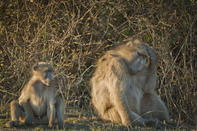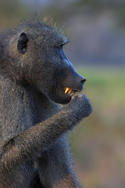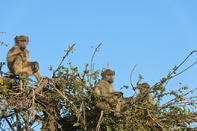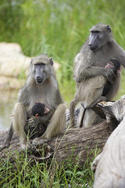Basic Daily Routine

Baboons have three priorities in a day. These are to find enough food and water, to find time to play and groom and to avoid predators. Baboons wake early and come down from their roosting sites to sun themselves.
During these early hours, important social activities take place in the form of grooming, playing, mating or fighting. Once these are taken care of, the troop will move off to forage. They may take a midday siesta if it’s hot. Feeding in the afternoon generally takes them on a circuit back towards a favoured roosting site, timed to reach it before dark so that they can engage in further social activities before retiring to the trees or a cliff face for the night.
Baboons are terrestrial primates and they spend the majority of their day on the ground. This is unusual for a member of the monkey family most of which are confined to safer tree habitats. Baboons will take to trees to sleep, to look for or escape danger or if the trees are fruiting. There are risks to living in the open and moving away from the refuge of trees. To overcome these risks, baboons live together in large troops.
There is an element of safety in numbers because of this as well as shared vigilance (lots of eyes and ears looking for danger). If danger threatens, the alarm is barked most noisily and contagiously. The dominant males then act cooperatively in the interest of defending their troop. They are large formidable animals and have canine teeth that rival even a lions’ in size. A predator would place itself at grave risk should it take on such a defensive band.
Communication

Baboons have a broad vocabulary including screams, squeals, barks and chatters. The ‘ba-hoo’ of a dominant male is a well-known sound in the bushveld as it echoes off cliff faces and down valleys. Vocal communication is used to maintain contact while foraging, to alarm for danger or to demonstrate mood in social contexts. Baboons have very expressive faces and rely on the use of their lips and brows to communicate visually as well. The combination of both vocal and visual signals significantly enhances their social communication repertoire.
Understanding some basic baboon communications: Smacking of the lips and soft grunting is friendly Threats are posed through raising the eyebrows and shaking grass Yawns with the eyes closed are relaxed and with the eyes open are excited Displaying teeth is a threat or show of dominance To appease or make peace with another baboon, they simply present their rumps.
Complex Social Systems

Baboons are long-lived animals that exhibit a great deal of intelligence, a criterion for animals that practice complex social systems. The young are born altricial which means they are rather helpless for some time after arrival.
They grow slowly and through various stages including infant, juvenile, adolescent and adult. As they grow, they learn, much like human children must, the subtleties of life in the community. They learn what to eat by watching other more experienced baboons as well as where to find food, refuges and water. Baboons are not territorial.
Because of their tendency to roam (sometimes up to 15 km) in search of food and water, they don’t limit themselves to a particular defended area. Often troops’ homeranges will overlap with one another in an area and although a great deal of shouting may ensue when they meet up, it’s only really sleeping sites (a valued resource to escape danger at night) that are defended by barking, chasing and branch-shaking.
Mating Rights

Baboons can see in colour. This adaptation supposedly enables them to identify ripe fruit (although they are prone to taking green fruit as well). The fact that they have colour vision means that visual advertising is possible during the female’s oestrus period.
A male baboon will simply recognize the readiness of a female to mate from the scarlet colour of the sexual skin around her rump (ano-genital swelling). This changes to different shades of pink throughout her cycle being brightest when she is on heat. Female baboons can be very promiscuous and will mate up to 100 times with various males when they are on heat.
This a female solicits from males by flashing her white eyebrows at them or simply presenting them with her rump. When she reaches the peak of her oestrus and at the time she is most likely to conceive, she will only mate with a dominant male.
By Megan Emmett